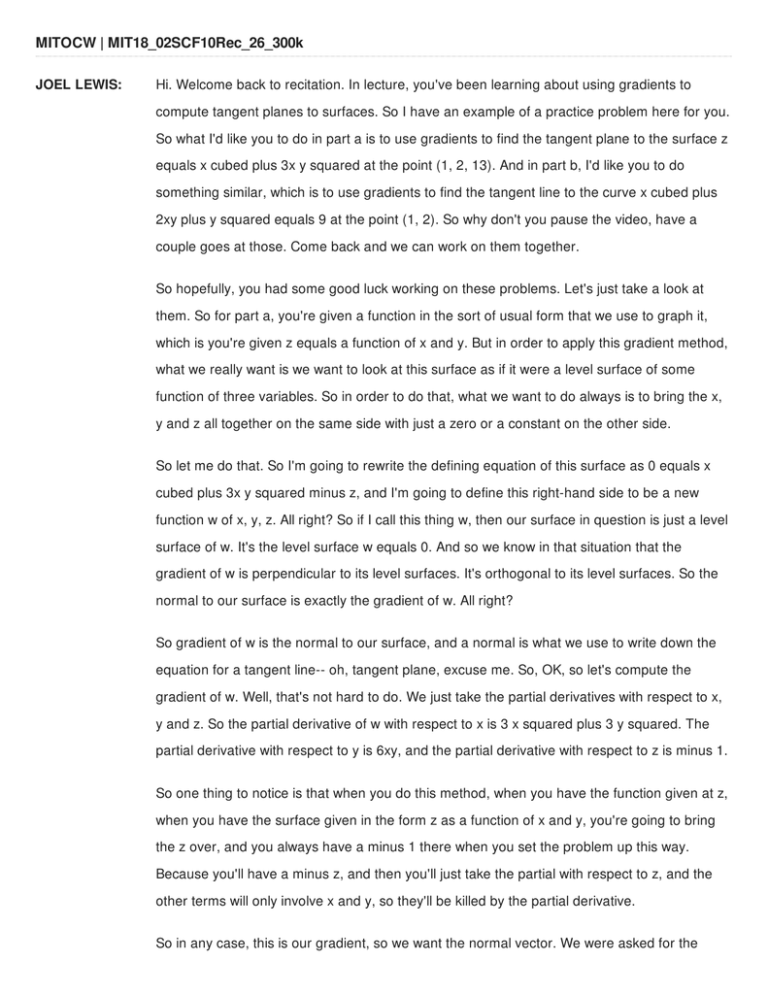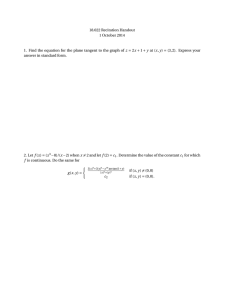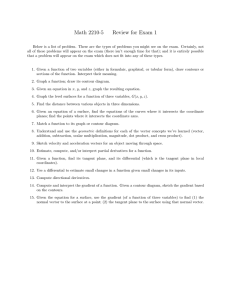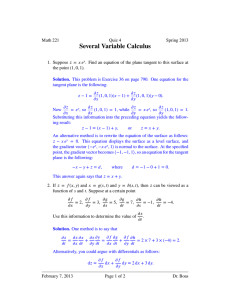MITOCW | MIT18_02SCF10Rec_26_300k
advertisement

MITOCW | MIT18_02SCF10Rec_26_300k JOEL LEWIS: Hi. Welcome back to recitation. In lecture, you've been learning about using gradients to compute tangent planes to surfaces. So I have an example of a practice problem here for you. So what I'd like you to do in part a is to use gradients to find the tangent plane to the surface z equals x cubed plus 3x y squared at the point (1, 2, 13). And in part b, I'd like you to do something similar, which is to use gradients to find the tangent line to the curve x cubed plus 2xy plus y squared equals 9 at the point (1, 2). So why don't you pause the video, have a couple goes at those. Come back and we can work on them together. So hopefully, you had some good luck working on these problems. Let's just take a look at them. So for part a, you're given a function in the sort of usual form that we use to graph it, which is you're given z equals a function of x and y. But in order to apply this gradient method, what we really want is we want to look at this surface as if it were a level surface of some function of three variables. So in order to do that, what we want to do always is to bring the x, y and z all together on the same side with just a zero or a constant on the other side. So let me do that. So I'm going to rewrite the defining equation of this surface as 0 equals x cubed plus 3x y squared minus z, and I'm going to define this right-hand side to be a new function w of x, y, z. All right? So if I call this thing w, then our surface in question is just a level surface of w. It's the level surface w equals 0. And so we know in that situation that the gradient of w is perpendicular to its level surfaces. It's orthogonal to its level surfaces. So the normal to our surface is exactly the gradient of w. All right? So gradient of w is the normal to our surface, and a normal is what we use to write down the equation for a tangent line-- oh, tangent plane, excuse me. So, OK, so let's compute the gradient of w. Well, that's not hard to do. We just take the partial derivatives with respect to x, y and z. So the partial derivative of w with respect to x is 3 x squared plus 3 y squared. The partial derivative with respect to y is 6xy, and the partial derivative with respect to z is minus 1. So one thing to notice is that when you do this method, when you have the function given at z, when you have the surface given in the form z as a function of x and y, you're going to bring the z over, and you always have a minus 1 there when you set the problem up this way. Because you'll have a minus z, and then you'll just take the partial with respect to z, and the other terms will only involve x and y, so they'll be killed by the partial derivative. So in any case, this is our gradient, so we want the normal vector. We were asked for the tangent plane at a particular point, I believe. Yes, at the point (1, 2, 13). So we need to compute the gradient at that particular point and that will be our normal vector. So the gradient at this point is-- well, we just plug in, so the gradient at (1, 2, 13). So x is 1. So this is 3 times 1 plus 3 times 4, so that's going to be 15, and 6xy is 12, and minus 1 is just minus 1. So this is the gradient vector at our point (1, 2, 13). So now we have a point, the point (1, 2, 13), and we have the normal vector 15, 12, minus 1, so that gives us the equation for the tangent plane right off. So the equation for the tangent plane, I just dot the normal vector with the vector connecting our point to the point (x, y, z). so that gives us 15 times-- well, our point is (1, 2, 3)-- so it's 15 times x minus 1 plus 12 times y minus 2 minus 1 times z minus 13 equals 0. So in point-normal form, this is the equation for that plane. Great. And if you wanted, you could rewrite this a whole bunch of different ways, but I'll just leave it there. So let's do part b. I guess I'll just start it right below here. So for part b, we have a curve x cubed plus 2xy plus y squared equals 9. So this is a curve that is defined by this implicit relationship between x and y. All right? And so what I want to do is I can do exactly the same process. We're going to do exactly the same thing. We're going to find the normal-point form for the tangent line, and so we're going to do that by defining a function f of x, y. In this case, it's a function of just two variables, because we're only working with a curve in two dimensions. Before, we had a surface in three dimensions, so we had a function of three variables. So f of x, y, and so then our curve is exactly a level curve of the graph of f, right? It's the level curve f equals 9. So in order to find the tangent line, I can do exactly the same thing. I can find the gradient. The gradient is normal to the tangent line and then I can use normal-point form. So the gradient of f is-- again, f is just a polynomial function so its gradient is easy to compute. It's 3 x squared plus 2y comma 2x plus 2y. And so we're interested in this tangent line at a particular point. So we're interested at the point (1, 2). So the gradient of f at (1, 2), well, I just plug in again, so I get 3 plus 4. That's 7. And 2 plus 4 is 6. And so again, the same analysis as we used in the tangent plane case works in the tangent line case. Let's come over here. So (x, y) is on the tangent line if and only if we have that the gradient dot-- so that's the gradient, [7, 6]-- dot the vector x minus 1, y minus 2-- this is the vector connecting the point (x, y) to our point (1, 2)-- is equal to 0, if and only if those two things are orthogonal. So this is-- i.e. 7 times x minus 1 plus 6 times y minus 2 is equal to 0. So this is the point-normal form for the equation of that line. And again, you could, you know, expand out and rewrite this in whichever forms you happen to like to see your equations of lines. So there you go. Using the gradient, we can compute tangent planes to surfaces. Similarly, we can use the same idea to compute tangent lines to curves. The point is that the gradient vector of a function is orthogonal to the level curves of that function. And so we use that to get the normal vectors to our curves or our surfaces, and with the normal vector, we can then easily compute the tangent plane or the tangent line. So I'll stop there.





